“You’re young enough to be my grandson,” Phyllis confides to me in the bumpy van ride through verdant waves of palm, ceiba and tiger bush. Our driver plows through muddied water of the washed out dirt road. Phyllis frowns. “I don’t like caves, and I’m not a good swimmer.”
Did the Actun Tunichil Muknal cave poster, complete with whip scorpions, skeletons of the sacrificed, and photos of tourists swimming into a murky mausoleum not deter her? Nevertheless, I promise to stay close. In my ignorance excitement boils over, blind to the path ahead that will harm both body and spirit.
In the potholed parking lot, rain pelts us as we don our plastic hardhats. I am the lone Canadian in a group of older Americans. A two-minute trail takes us to Roaring River. Swift riffles heaving from the cloudburst betray a deadly undercurrent. There is no bridge.
“Our first crossing,” Oscar, our guide, informs us as though commenting on the inclement weather. “There will be six total.”
I am stunned. This wasn’t in the brochure.
Phyllis reels next to Roaring River, hands on her itty bitty hips, a stupefied pensioner. “How deep?”
“To my waist,” Oscar says. He is a robust man, with calves for biceps, a Belizean Rambo with a potbelly emerging through his mesh shirt.
“What!” Phyllis exclaims. “My neck barely reaches your waist.”
Oscar takes her hand curtly, and she unwillingly braves the current.
I fall in behind everyone else, the good soldier. Our first crossing is slow but safe. The next group’s guide, rope-in-hand, pounds through Roaring River. Oscar ties this rope around a trunk, tactile security for those to come. Not us: Oscar is our drill sergeant, and trailblazes into the jungle at twice the speed Roger, Phyllis’ 72-year-old husband, is able to follow.
The river meanders across our path a second and then a third time. Oscar, impatient at our comparatively sluggish pace, reaches the far shore just as my foot enters the current. Phyllis asks me to carry her bag, and she and I trudge through the slippery, algae-covered rocks. About two-thirds across, water tugging at my thighs, I hear a splash to my right. Phyllis is down, cradled by the current as it carries her thrashing body downriver. I thrust my legs toward her, trip on submerged bedrock, manage to keep my balance and our collective bags dry, and clutch the toes of her flailing foot. I brace myself against the rush of the river.
She stretches out a frail hand. Yet my ten fingers are occupied. I look from her foot to her fingers, practice the switch again with my eyes, and then release my grip. Before she sails downstream, I lunge with my free hand and wrap my fingers around hers. “If it weren’t for you,” she remarks afterward, “I’d be halfway to the ocean.”
The clouds do not let up. Others grumble; I see the constant deluge as suitably adventurous. Amidst wild jungle, a short trek past abandoned termite mounds that rise up like miniature mud cities, lay a row of palapa-roofed picnic tables. Lunch time. My veggie sandwich is a bit dry, but the fried plantains are delish. Oscar advises us to empty our bladders, as we will spend hours in the dark before reaching today’s highlight: the crystal maiden. After all this, we have yet to enter the cave.
He attaches headlamps to our plastic hardhats, then buries our socks and cameras in his dry bag. “Today, safety is priority,” he barks. “Therefore, I am the boss! Inside the cave, we must pass directions from one person to the next.”
Actun Tunichil Muknal, the Cave of the Stone Sepulchre, in reference to old spirits and skeletal corpses, ranks as the top Belize attraction. Except for one added Home Depot ladder–no boardwalks, no spotlights, no escalators–the ATM cave has changed little since the reign of the ancient Mayans, who ventured within this holy quietus to perform bloody rite and ritual.
The cave entrance opens before us like jaws of the Earth, the river its liquid tongue. My wife, Jenn, opted out with this reason: “I think you’ll enjoy yourself more if I’m not there.”
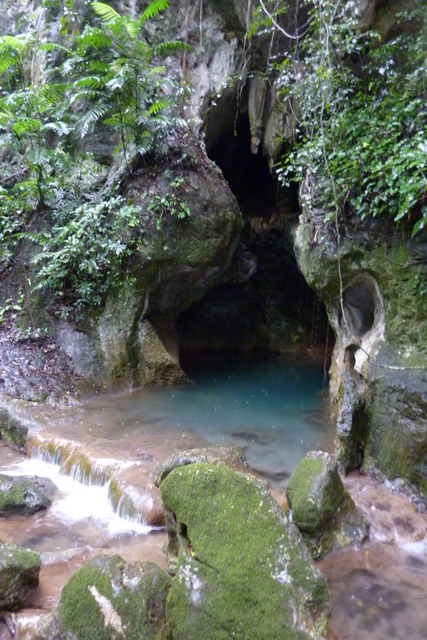
The towering entrance to Actun Tunichil Muknal, leading to a vast network of river tunnels in the earth.
Oscar hefts his leak-proof bag of tourist socks and digital cameras. “Here, we swim. Keep your heads up! The headlamps are not waterproof.”
“Just like Goonies,” someone remarks. One-by-one we waddle onto a slick slab of rock, jump like tentative ducklings into a pool of sapphire, then doggie paddle into the humid darkness.
Our headlamps cast meagre light in this underworld of quartz walls and monstrous stalactites that hang from above like the fangs of some forgotten beast. My toes strain to touch solid ground. Oscar commands something I can’t hear. I have again chosen to be last–for others’ safety, and to linger amongst these geological marvels. Two fluid hands formed these elaborate tunnels: the erosive flow of the river, and rain water that seeped from above to dissolve huge slivers of limestone over the course of 100,000 years.
“Sharp rocks to the right,” the guy ahead relays.
The farther we explore into this long mouth of Mayan civilization–sliding between sheets of flowstone and climbing bulbous stalagmites–the more the guy ahead decides to be a smart ass.
“Wet area ahead!” he indicates with a sweep of his hand.
“Thanks,” I mutter, tiptoeing through nipple-high water.
We stop in the heavy, nocturnal stillness. Oscar helps Phyllis and Roger scramble up a steep staircase of boulders, while I ponder this sacred, once-hidden world of shadow and sacrifice.
Then I see the spider.
Tarantula-sized, with eight long, razor-like legs clinging to sheer rock. I could reach out and touch it. I’m a biologist. I handle snakes. I take macro shots of hissing cockroaches. But when it comes to arachnids, I’m like my mother with millipedes: too many limbs, too easily startled, and definitely too icky.
I’m trapped between the spider and the smart ass. “What you got there?” he inquires.
“A spider,” I whisper, not wanting to trigger this subterranean arachnid into action. “A big spider.”
“Really?” he exclaims, and sticks his headlamp far too close to this wolf spider on steroids.
Thankfully, the bottleneck ahead disappears. I wade past my eight-legged acquaintance and clamber up to the main chamber, known as The Cathedral, whose genesis is a flat rock shelf.
“Shoes off! Socks on!” Oscar orders. This no socks, no service policy keeps our skin oils off the sacramental stone. He hands us our cameras. Someone complains that the humidity has fogged up his lens. I look up. My headlamp reveals an angry spirit, a mystic shapeshifter that dances before my roving eyes. Perhaps this is a guardian. I blink, and the ephemeral spirit crumbles into mist. Am I guest here, or trespasser?
I tug on dry socks and twist through a narrow passage, scraping spine and knee, and enter The Cathedral.
I am familiar with the word cavern: a large, dark, underground chamber. I have spelunked the lava caves of Iceland and meditated in Sri Lanka’s golden cave temple of Dambulla where elaborate murals colour every surface. Neither truly deserve the word cavern.
Here, in this football-sized field enclosed by limestone, magnificent columns stretch from floor to ceiling like something from Lord of the Rings, while immense drip curtains of sensuous stone put Picasso to shame. We have stepped into the divine. Miracles dangle above in the form of elegant rock draperies and soda straw stalactites. My dim light cannot fully illuminate these vast mysteries sculpted by the collaborative hands of water and erosion. Sunless rock is the canvas, single drops of limestone-laced water the artist. Many shapes remind me of candle wax, huge rivulets that flow, snake and coil into countless latent architectures. This supernatural art demands patience, and yet Oscar hastens us deeper into The Cathedral.
We are not alone. This is a place of pious ritual and bloodthirsty deities. I take delicate steps in my wool socks. The path is well-trodden. We pass 1,300 year-old ceramic bowls used in sacrificial ceremonies, many with kill holes to allow the spirit to escape. Most are shattered. “Tourists stepped on them,” Oscar says, matter-of-fact.
Oscar points to a rocky outcrop that juts upward like the head of an old crone. “Ixchel, the jaguar goddess of medicine and midwifery.” With his flashlight, he spots her flat head. Shadows flicker behind, dancing the goddess to life, much like the Mayans witnessed by torchlight. A nightmarish effect.
Eighteen corpses were found in The Cathedral, including children. Oscar stops at a site outlined by red tape on the floor, a pathetic barrier to tourist stupidity. A skull lies above fractured ulna and femurs. The forehead is flat: Mayans strapped boards to the heads of babies in order to achieve this desired attribute, the cleavage of Mayan society. A precise hole caps the skull. “A kill hole?” someone asks. “No. A camera was dropped onto it.” I cover my Panasonic Lumix in both hands, guilty by association.
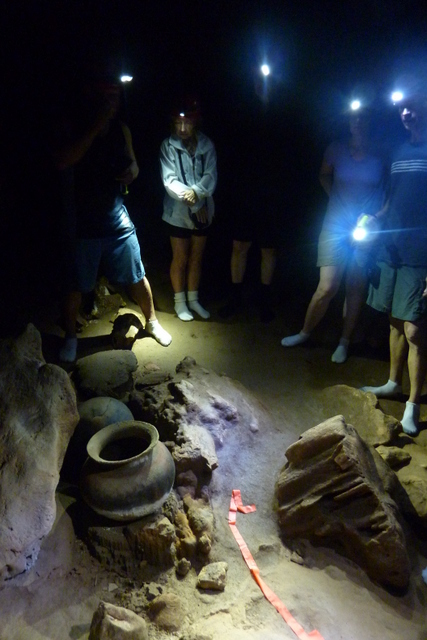
We had to wear socks inside The Cathedral, so as not to damage the ancient Mayan pottery and skeletal remains.
We pass other groups, some much larger than ours. I feel irritated. Irritated by the careless step of the tourist. Irritated by the guy who looks bored and checks his watch. Here we stand, deep in the jungle, inside a certifiable cavern that took ten millennia to form, and someone yawns. Perhaps they are uncomfortable. I want to shake them, bring them to the aliveness and privilege of being here.
I am irritated with myself. I paid for this. I might trail behind, to pretend I don’t belong, but I cannot escape the tourist herd.
The end nears. The Home Depot ladder helps us ascend a tricky slope.
“This is the highlight,” Oscar reminds us. He leads us past a set of jumbled bones—many cracked by fickle feet—to another, complete skeleton.
“The crystal maiden.”
Her bones shine like diamond-coated ivory, limbs spread-eagled, pelvic girdle protruding the highest. “She was 17 to 21 years old. Likely a sacrifice.”
She lies there, just past a small rope that would not be out of place in the Smithsonian. In the dim light, her slender vertebrae embedded in the cave floor, I notice her white skull is tilted forward, her jaw arched in a frozen scream.
This is the main attraction. A girl sacrificed to the gods. Did she consider it an honour, or a terror?
Oscar’s face is inscrutable. He takes tourists here several times a week to gawk upon calcified remains of his ancestors.
Now, our time is up, escorted away to accommodate the next group’s corpse viewing. But I am not ready. This so-called highlight felt anticlimactic, a brief glimpse upon this Mayan maiden whose bones shimmer in tragic awe. I feel at odds as we retrace our steps, a kind of shameful sadness. I wanted an opportunity to pay my respects, to offer…thanks? Forgiveness? Clemency? I’m not sure.
At the entrance of The Cathedral, we slip our feet into soggy shoes and descend to the river tunnel that winds us out of the cave. The sky is a welcome window to colour and light, yet solemn cloud obscures the sun. We finish the remnants of our mediocre lunch and ford Roaring River thrice more.
On the road back to San Ignacio, the van is full of quiet and bedraggled rookie spelunkers. In my exhaustion, I question my part in this tale. Have I simply contributed another eighty dollars to Belize tourism, or have I pushed a sacrilegious tourist train one tie closer to being a wreck? I ponder the wonders of the day, the carvings of the river, the shadow of the goddess, the tremendous art walling The Cathedral that bore witness to that girl’s final breath.
Someday soon, foreigners will–or should–be barred from the ATM cave, excepting anthropologists and archeologists; that is, those with the credentials to dispel ignorance and apathy. As the van rolls to a stop, I find it hard to take solace in my mindful musings. I step out into the sombre rain, and take pride in these parting words.
“Thanks again for saving my life!” Phyllis calls after me.

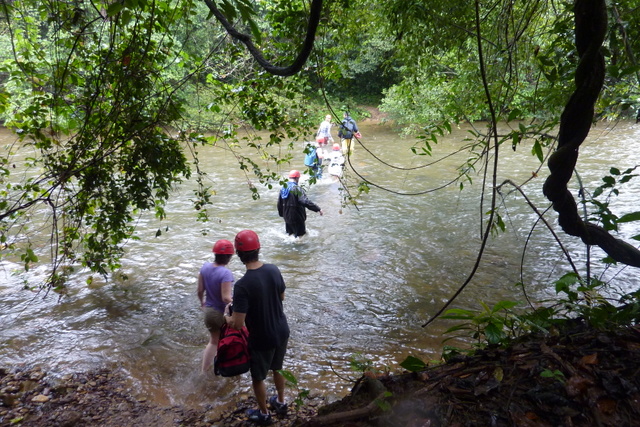


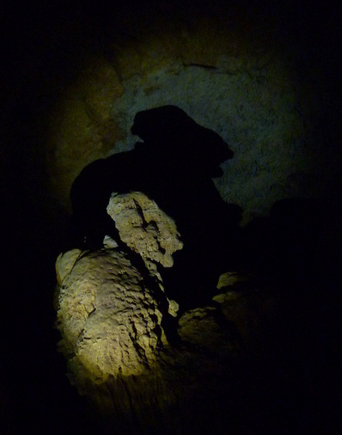
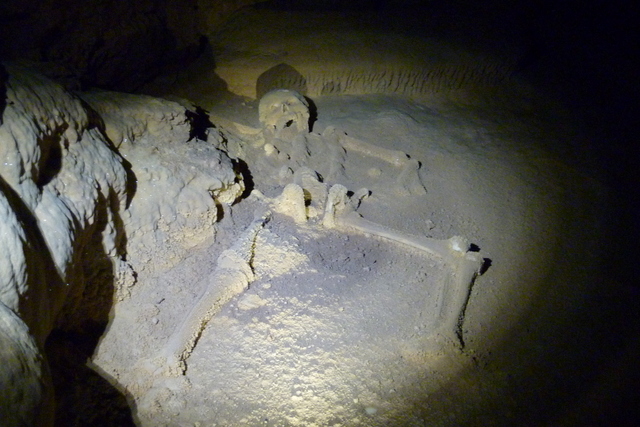
I loved this! Just visited the cave and you captured some of my emotions perfectly! What a privilege it was to go through the cave!
Thanks kindly for the comment. The cave truly is extraordinary to go through, and indeed a privilege. Although five years have past since I spelunked this cave, I still vividly recall the nuances of the experience.